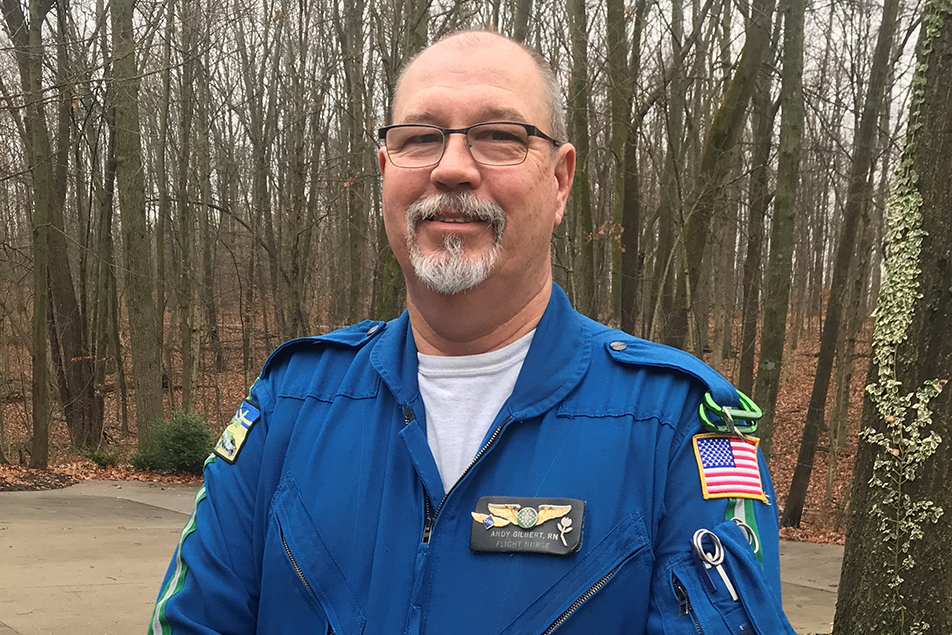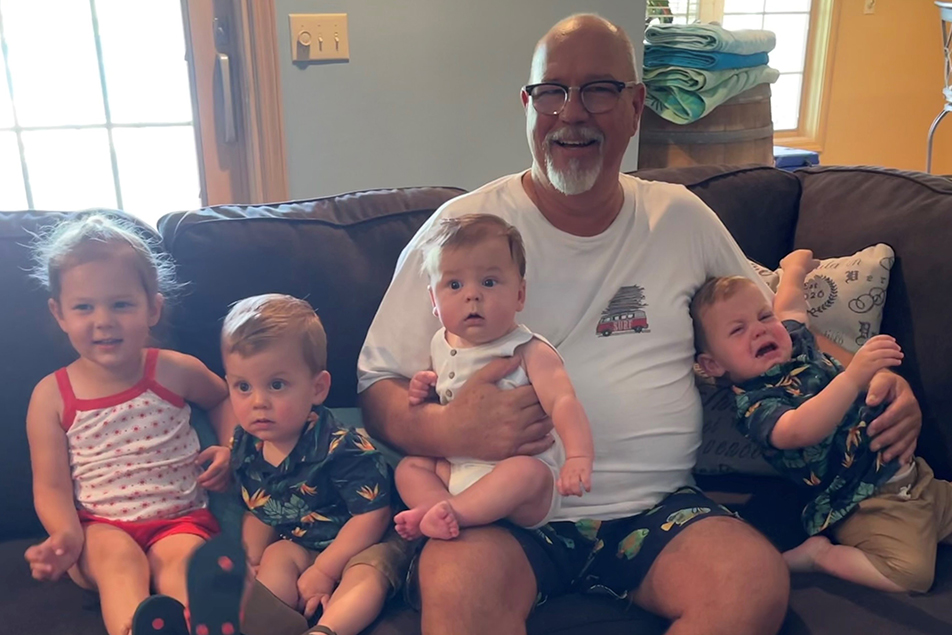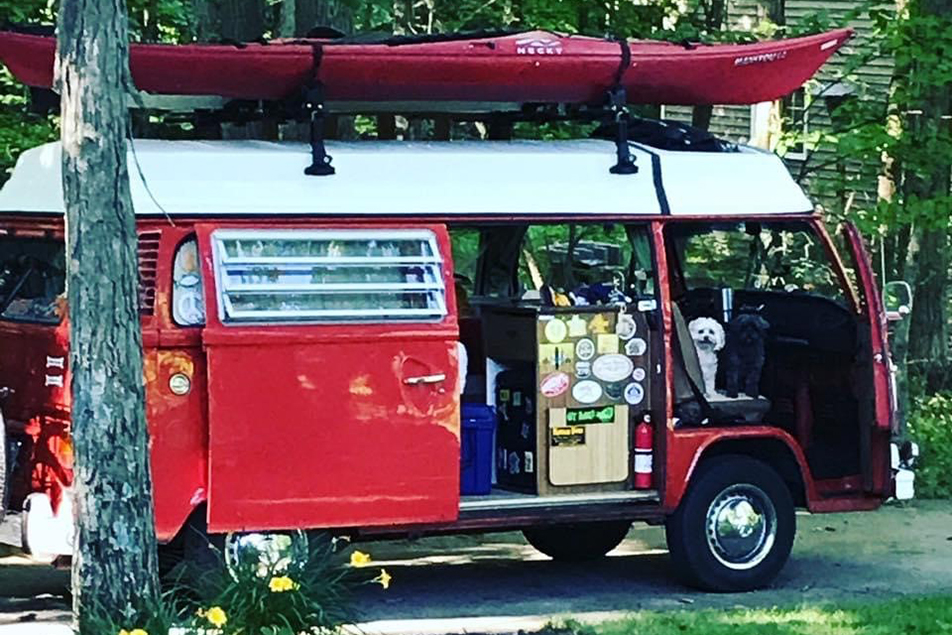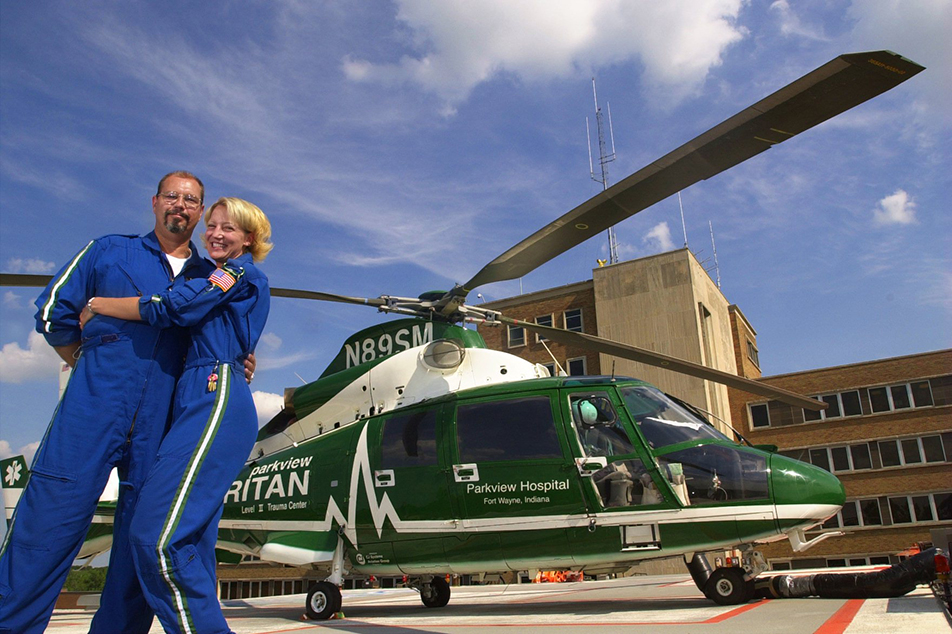
For 32 years, Cletis “Andy” Gilbert, has been the person who arrived on the scene when the call came in. He is the last original Samaritan crew member, and on November 18, he will take his final shift as a flight nurse. We asked him to reflect and share some of his fondest memories from his time at Parkview.
I was the first crew member ever hired for Samaritan, and I’m the last of the original team to leave, which is pretty cool. I actually worked for Parkview for about 38 years, all together.
In 1979, when I was in college, a friend of mine had a job as a parking attendant for the health system. He became a respiratory therapist and his boss asked if he knew anyone who might want his old job. I was pre-med at IU. I sat in a heated structure and basically got paid to study all night, so it was a perfect deal for me at the time.
I got to know the folks in the ER and became interested in the emergency aspect of care. In between my pre-med courses, I decided to take an EMT class and assume a part-time job on an ambulance. I loved it!
Then, one day, Jenean Gibbons, who was over the Parkview ER, asked to speak with me. “You would be a perfect paramedic,” she said. “What’s a paramedic?” I asked. In 1980, it was a brand-new field. Gene helped me apply for the first paramedic class in the state of Indiana, and I got in. In this new role, I found what I was looking for.
See, when I was 15, one of my best friends was a 75-year-old man named Oscar. He was the grandfather I never had. He taught me to hunt and fish and track. Oscar had a stroke, and I helped take care of him during the final year of his life. One of the last things he ever told me was, "When you get older and decide on a career, find a job that gives you more than a paycheck. Find a career that, when you're old and gray, allows you to look back on your life and be proud of what you've done with it." That was my goal, and at 62, I’m proud of what I've done, and when I look back, I know I've made a difference.
I worked as an ER Tech 2, which was a new position, for two years. Then, in 1984, I went to be a paramedic with TRAA, covering Fort Wayne and Allen County.
In 1989, TRAA was going through contract negotiations. During a union meeting, they decided to strike, and ethically speaking, I just couldn't do it, so I quit. Here I was, married, with two little kids, a house payment, a car payment, and I turned in my uniform. I just couldn’t do that to the people who needed us. The people who expected us to show up when they called 911.
I picked up the phone and reached out to Sue Chaney, who was over the Parkview ER at that time, and told her I needed a job. I also decided to go to school and become a nurse. I returned to Parkview officially in September 1989.
In October of that year, Janine Gibbons, walked through the ER. “Oh good, you’re here,” she said. “When you get off would you please come to my office?” Of course, I thought I was going to be fired. But when I got there, it was her and Dan Garman, the division director over Emergency Services. “We're starting a helicopter, and we want you to be on it.”
I 'd heard rumors of a flight program, but it certainly wasn’t in my plan. I decided to give it a try and see what it was like. That was 32 years ago, and I can honestly say, up until the last year, I’ve loved every single second of it.
Building a legacy
It was amazing trying to figure out what the Parkview Samaritan program would be. There really wasn’t a game plan. We hired pilots that came from other medical programs. Our lead pilot, Mike Burke, and his significant other, Anne Frederick, a flight nurse, both came from St. Vincent’s Toledo, and that was our base staff for a while. We had their knowledge. We made decisions as a group, wrote polices and figured out what equipment we needed. We were all together for six weeks before dedication day, November 18, 1989.
We actually left the dedication to take our very first patient flight. Ironically, I was on a flight with the same patient 10 years later, and he remembered me!
.jpg)
Seeing some of the things we’ve seen and sharing some of these runs, you really develop lifelong friendships. The truth is, people think this is a glamorous job, but it’s really tough. You have people who, no matter what you do, no matter how fast or well you do it, they still pass away. And there’s no way to sugarcoat that. It’s just awful.
One of the things Dr. Alex Antalis told us on Day No. 1, when we were all sitting in a conference room figuring out what Samaritan would be, was, "I’m going to save you some grief. It took me several years to figure this out and several years to figure out how to deal with it, but there's such a thing as a ‘fail injury.’ Some of these people you're flying are dead, they just don't know it yet. They have injuries they cannot survive. They might be looking at you and talking to you, but they will not survive."
You have to be in it to make a difference for people. That’s what it takes to stick around. You have to be willing to take a bad experience and put it on a shelf to make yourself available for the next person, on the next flight.
Connecting flights
When I look back, I’m most proud of some of the connections I've been able to make with people I've had the opportunity to fly. In the ‘90s, there was a woman, who I’ll call “Mary”, who was involved in a horrible crash in Wells County. Her mom and her sister were both killed. Mary, who was 25, had suffered severe injuries. Her face was crushed, and her eyes were swollen shut. I went and saw her in the ICU after the flight. She was intubated, but I spoke to her, and she squeezed my hand. When I came back in a couple of days, she was able to scribble notes. She wrote, “I will never forget your voice.” For the next 10 years, every time we flew to the Wells County Fair, I made sure I was working. And every year, Mary came to visit. She got married, had kids, and brought her children to see the helicopter.
And you have to have flights like that, so that you can come back and face another day. So that you can be restored.
.jpg)
About 20 years ago, I flew a young woman who was sitting on a log by a lake with her boyfriend, when someone shot her, mistaking her ponytail for a groundhog. On that 20-year anniversary, she reached out. When she discovered I was still flying, she came and brought her family to see the helicopter. “I will never forget your voice,” she said. “You told me I was going to be OK and that you were right there. You would not let me go.”
Hanging up the suit
The COVID pandemic has really changed so many things about what we do. It’s taken a toll on me and, if I can’t put 100% in, it’s time to leave.
I stopped writing down all of my flights when I hit 10,000. There have been so many, and to be honest, it’s tough on my body. My wife, Staci, is the Samaritan Program Manager now. She’s my boss, actually. And on November 18, exactly 32 years from that dedication day, she will accompany me on my last flight.
It’s poetic, in that we’ve never actually flown together. For years, we split our schedules so that we could raise a family. She'd work days, I'd work nights and then we'd have three days off together. In many ways, I missed my children growing up. I’m ready to be more present.

The next chapter
I’m excited and nervous at the same time. We had a farm by Wolf Lake, Indiana, for 20 years, so every shift, we would each drive 35 miles each way. We restored every inch of a massive old mansion in the middle of nowhere. When the kids grew up, they each graduated high school and moved to Fort Wayne. When the last one went, we decided it was time to sell. We raised them in the country, and that’s what we’d wanted.
A few years ago, We bought a new property. It’s four acres on a ten-acre lake. We’re surrounded by woods. We have wild turkey, deer, fox and we get to watch the Canadian geese raise their families and teach them to fly each year. It’s like On Golden Pond, but it’s Gilbert Lake. I’m really looking forward to more fishing.
I have four beautiful grandkids, so I plan to open Papaw’s Daycare on November 19.

I also have a 1957 Porsche convertible, named Sofie, and an old Volkswagen bus, Mildred. Mildred is all set with solar panels and water purification. I can take Sofie out for a spin and then, when I really want to get away, get into Mildred and go find some sunshine. A fulfilling career was Plan A, and Mildred is my Plan B.
Leaving a legacy
Walking away will be tough, but I know that it’s the right time for me. I've done a lot of teaching over my years, and I’ve always tried to keep things simple. Medicine and life can become really complicated, but when it comes down to basic emergency trauma care, it’s very simple; Keep them breathing, replace blood or fluids as needed, and get them to the hospital care team as quickly as possible to give them the best chance at survival. The teams in the ERs, surgeons, ICU staff, they save lives. I just give people a better chance by getting them there faster. I hope that I taught others how to act quickly and do the right thing.

I ran into a paramedic the other day, who I’ve watched grow up in the field. When I told him I was leaving, he said, “Who's going to come when I call? Who's going to come when I need you?”
I hope that, when I'm gone, the people who show up when the calls come in are better than I've ever been. I've had the opportunity to help pick my replacement and she's one of the best nurses I've ever known. Samaritan will be here for a long time. I’m excited to see how my wife thrives in her position and the program grows.
For so many years I've wondered who I’m going to be when I’m not “Andy from the helicopter.” Finally, in this last year, I’ve decided I’m OK just being Andy. Just being Papaw. I've tried to take care of everybody. Now I’m going to take care of myself.



